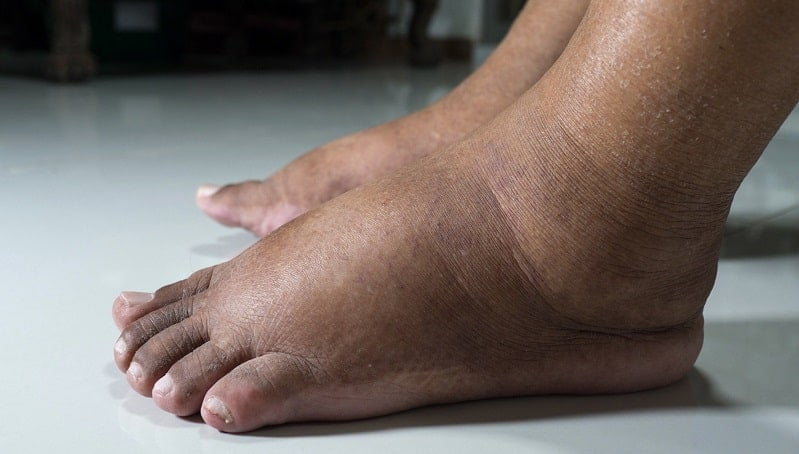Leg and foot swelling can complicate daily life with diabetes. When fluid leaks from the skin, people often call it “weeping legs.” Understanding why diabetes swollen feet happen helps you act early, protect skin, and know when to seek care.
Key Takeaways
- Identify triggers early and protect your skin barrier.
- Check for infection, redness, or sudden asymmetry promptly.
- Use elevation and compression cautiously with medical guidance.
- Review medications that may worsen fluid retention.
Diabetes Swollen Feet
Swelling in the lower legs and feet is usually peripheral edema (fluid buildup in tissues). In diabetes, edema may stem from impaired circulation, nerve damage, kidney or heart disease, or medication effects. If swelling becomes severe, clear or yellowish fluid can seep through thin or damaged skin. People often describe this as weeping legs.
Edema raises skin tension, which increases the risk of cracks, ulcers, and infection. Neuropathy (nerve damage) can mask pain, so injuries go unnoticed. This is why routine foot inspection, basic skin care, and glycemic control matter. Early action reduces complications and supports mobility and comfort.
Common Causes and Risk Factors
Several mechanisms can drive lower-limb fluid accumulation in diabetes. Chronic venous insufficiency and lymphatic dysfunction reduce fluid return from the legs. Long-standing hyperglycemia may stiffen blood vessels and slow healing. Kidney or heart disease can also promote water and salt retention, which intensifies swelling.
Some drugs can worsen edema, including dihydropyridine calcium channel blockers (e.g., amlodipine), certain thiazolidinediones, and vasodilators. Insulin initiation occasionally triggers transient fluid retention. If you notice diabetes leg swelling and redness with medication changes, inform your clinician. For broader context on kidney involvement and swelling, see Diabetes And Kidney Damage for how reduced filtration contributes to edema.
Edema and heart function often intersect. SGLT2 inhibitors may modestly aid fluid balance in heart failure. For emerging evidence relevant to volume status, see Dapagliflozin For Heart Failure to understand potential cardiorenal effects. Conversely, some agents can promote retention; for a discussion on fluid issues, see Pioglitazone And Heart Failure and why monitoring edema matters.
For general foot health guidance, the CDC offers practical prevention tips; review the CDC foot care guidance for daily routines that reduce complications.
Symptoms and Red Flags
Typical symptoms include tight shoes or socks, shiny or stretched skin, and pitting after pressure. Weeping may occur if skin blisters or breaks. Watch for warmth, new pain, tenderness, or a bad smell. These signs may suggest infection and require prompt evaluation. Fever, spreading redness, or drainage are concerning.
Sudden one-sided swelling, calf pain, or shortness of breath may indicate a blood clot or cardiopulmonary issue. Seek urgent care if these occur. People often ask, are swollen feet dangerous? They can be if infection, clots, or heart failure underlie the swelling. Act early to prevent skin damage and deeper complications. For skin-care and infection pointers, see Diabetes Skin Problems to compare rashes, ulcers, and warning signs.
Evaluation and Tests
Clinicians assess symmetry, pitting, temperature, pulses, and sensation. They inspect for ulcers, fissures, and fungal changes between toes. Lab tests may include kidney function, electrolytes, albumin, and thyroid levels. Ultrasound can evaluate veins for clots or reflux. When arterial disease is suspected, an ankle-brachial index helps guide compression safety.
Your clinician will also review medicines that may cause edema and discuss recent changes in insulin or antihypertensives. Describing your patterns helps: time of day, activity level, salt intake, and footwear. If you note diabetic edema symptoms with new drugs, bring the timing and dose details to appointments. For context on blood pressure therapies interacting with circulation, see Bystolic Blood Pressure Guide to understand antihypertensive effects on peripheral flow.
Home Strategies and Self-Care
Protect your skin first. Moisturize intact skin daily, keep web spaces dry, and trim nails safely. Elevate legs above heart level several times daily. Gentle ankle pumps and calf stretches help the muscle pump move fluid. Use well-fitted, cushioned shoes and seamless socks. Consider compression socks if your clinician confirms adequate arterial flow.
Focus on practical steps if you wonder how to reduce swelling in feet. Balance activity with rest. Avoid long periods of standing or sitting. Weigh yourself regularly to track fluid changes. Treat small skin breaks quickly and keep dressings clean. If weeping occurs, non-adherent dressings and leg elevation reduce skin maceration. For a broader library of diabetes topics, browse Diabetes for related education and self-care guides.
Tip: If compression is advised, start with mild pressure and ensure stockings fit without rolling. Replace worn pairs regularly.
Nutrition and Hydration
Dietary sodium strongly influences fluid retention. Aim for consistent hydration while moderating salt. Favor whole foods, lean proteins, and high-fiber carbohydrates that steady glucose. Adequate protein supports wound healing if the skin weeps. Alcohol can worsen inflammation and balance issues, so drink sparingly. Limit ultra-processed foods with hidden sodium and sugars.
People often ask what to drink to reduce swelling in feet. Water remains first-line for hydration. Unsweetened herbal teas may be acceptable, but avoid products marketed as “detox” diuretics without medical advice. Discuss electrolyte drinks if you take diuretics. Evidence-based foot care resources such as MedlinePlus edema overview explain how salt and fluid balance affect swelling.
Clinical Treatments and When to Seek Care
Clinicians tailor therapy to the cause. Options may include compression wraps or stockings, leg elevation protocols, supervised exercise, and wound care for weeping skin. Infections require antibiotics and careful debridement when needed. When heart, kidney, or liver disease contributes, underlying management takes priority to control fluid shifts and protect organs.
If medication is appropriate, diuretics may be prescribed short term. For general information about a loop diuretic sometimes used for edema, see Furosemide to understand class role and precautions. Ask about diabetic leg swelling treatment if you have recurrent flares or ulcers. To learn how insulin changes can relate to edema, compare profiles in Toujeo Side Effects and Levemir Side Effects for context on fluid shifts after dose adjustments.
Medications: Metformin, Insulin, and Others
Most people tolerate metformin well, but discuss metformin side effects with your prescriber if symptoms change. Gastrointestinal issues are common early on. Peripheral edema is uncommon with metformin itself; evaluate for other causes like heart or kidney disease, high-salt intake, or companion drugs. Women may report patterns differently, but management principles remain similar.
If you use a combination like metformin with an SGLT2 inhibitor, side effects can overlap. For combination therapy considerations, see Synjardy Side Effects to compare expected versus concerning reactions. For a comprehensive review of metformin’s safety profile and cautions such as lactic acidosis risk in specific settings, consult the MedlinePlus metformin monograph and discuss implications with your clinician.
Prevention and Monitoring
Consistent glucose control, weight management, and regular movement reduce fluid shifts. Check feet daily for swelling, redness, warmth, or new blisters. Keep toenails even and avoid bathroom surgery. Replace worn footwear and socks. Track bodyweight and leg measurements to spot trends. Address constipation and high-salt meals that worsen fluid retention in type 2 diabetes.
Log symptoms along with blood glucose and blood pressure. Structured self-monitoring can highlight triggers and show improvement over time. For easier fingerstick routines, consider using Accu Chek Softclix Lancets so you can record values consistently. When redness spreads, wounds fail to heal, or edema rapidly worsens, prioritize medical review. For multi-system impacts of diabetes that may relate to lower-limb symptoms, see Diabetes And Joint Pain to consider broader musculoskeletal contributors to mobility limits.
Recap
Lower-limb swelling in diabetes has many causes, from venous disease to medication effects. Protect skin, elevate legs, and moderate salt while you address root factors. Seek help quickly for sudden swelling, spreading redness, or shortness of breath. Small, steady steps lower risk and support long-term foot health.
Note: For general education across diabetes topics, explore additional articles and guides to build a personalized plan that fits your routine.
This content is for informational purposes only and is not a substitute for professional medical advice.



